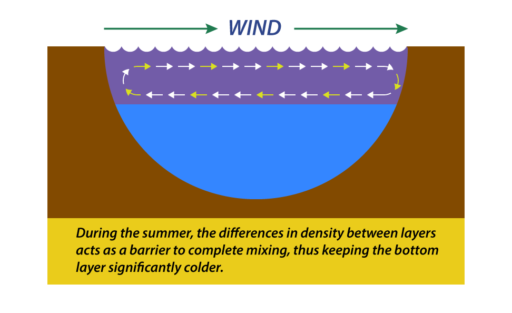Browse this collection of downloads and resources related to the Slim Jim and Geo Lake Plate products from AWEB Geo Supply.
Thermal stratification is when bodies of water "divide" into distinct layers of density due to different temperatures. So, if you've ever been treading water in a lake and noticed the water near your feet was significantly colder than the surface, then you've experienced Lake Stratification!
These distinct layers of warm and cold water are formed through the heating of the sun. Since the solar radiation only penetrates about 6-8 feet of water, the top layer is naturally going to be warmer than the lower depths. The differences in temperature will depend on the season and the overall climate surrounding the body of water, but each body of water has a general cyclical pattern that is repeated from year to year.
Example: Large bodies of water rarely freeze over in the southern United States, so those lakes and ponds will typically have a higher spread of temperatures in early spring compared to lakes in the colder northwest that are in the process of melting their surface ice.
Understanding the Layers of Thermal Stratification
 There are 3 distinct layers of water, each with a different range of temperatures, which comprise the thermal stratification within a lake system. Since heated water is less dense than cold water, the warm water "floats" on top of the cold layer of water. The surface layer of warm water is called the epilimnion. The cold layer below the epilimnion is called the hypolimnion. And the two layers are separated by a thinner layer of water - the thermocline (or metalimnion) - that quickly changes temperature with depth.
There are 3 distinct layers of water, each with a different range of temperatures, which comprise the thermal stratification within a lake system. Since heated water is less dense than cold water, the warm water "floats" on top of the cold layer of water. The surface layer of warm water is called the epilimnion. The cold layer below the epilimnion is called the hypolimnion. And the two layers are separated by a thinner layer of water - the thermocline (or metalimnion) - that quickly changes temperature with depth.
In summertime, when the top layer is most warm and least dense, this becomes a deterrent to the water mixing throughout the lake. Even though wind circulates the surface water, the warm water in the epilimnion is unable to penetrate the more dense cold water in the hypolimnion. As a result, the water is only mixed in the epilimnion.
Additional Resources for Lake Stratification
Byron Shaw, Christine Mechenich, and Lowell Klessig composed "Understanding Lake Data", a comprehensive, helpful guide to help people understand information about lake water quality and to interpret lake data. Each lake possesses a unique “personality,” or set of physical and chemical characteristics which may change over time. Lakes exhibit
chemical changes on a daily basis while other changes, such as plant and algae growth, occur seasonally.
Conserving Clean, Potable Water for Life
A GeoExchange, comprised of a Slim Jim® / Geo Lake Plate®, is an environmentally friendly, eco-smart alternative to the traditional cooling tower! It can significantly reduce potable water waste, eliminate evaporation, blow down, and even exposure to chemicals!





